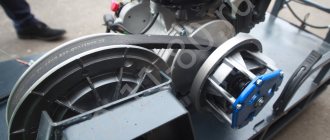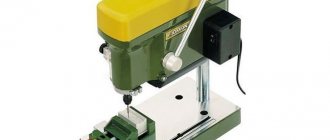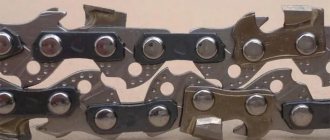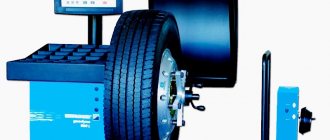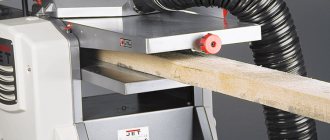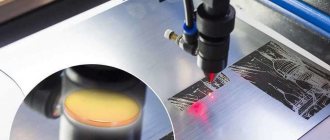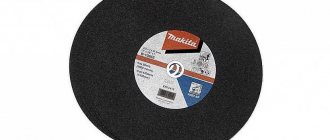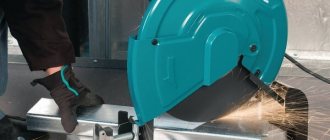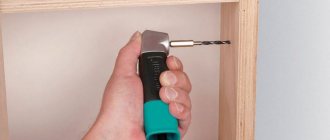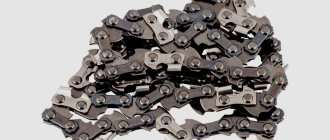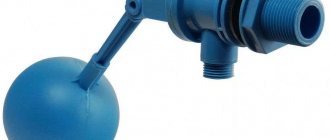A circular saw is a staple item in any woodworking business' toolbox. It doesn’t matter whether it’s a large industrial sawmill, a medium-sized furniture workshop or even a small home carpentry workshop - a circular saw is indispensable when working with wood!
In any case, the processing of wood or other wood material begins with its dissolution and cutting into blanks using a circular saw. It is this circumstance, which made the circular saw such an important element of the toolkit of such enterprises, that determined the huge selection and range of their varieties on the modern woodworking equipment market.
How can you avoid getting confused in this variety when choosing and purchasing a circular saw, and buy exactly what you need? In order to make the right choice, you need to understand in more detail what a circular saw is, what types it comes in, and what each type is intended for.
What should you pay attention to?
When choosing a tool, it is very important to pay attention to the depth of cut and the speed of the blade. The cutting depth is selected depending on the material being worked with, for example, the thicker the wooden block, the greater the required cutting depth. The quality of the processed surface depends on the rotation speed: the higher the rotation speed of the disk, the better the surface of the workpiece.
After a high-quality cut, the surface will not need to be further processed. It is also worth paying attention to the tool manufacturer. Large manufacturers seriously monitor product quality. Before purchasing, be sure to consider the engine power. For home work, saws with an 800 W motor are suitable, while for professionals, machines with motors from 1200 W are suitable. It is necessary to immediately pay attention to the parameters of parts that must be replaced over time. For example, the mounting diameter of the cutting disc.
Technical characteristics of circular saws
Main technical characteristics that you should pay attention to when choosing a circular woodworking machine:
- power;
- depth of cut;
- spindle rotation speed;
- desktop size;
- bed (steel, cast iron, stamped sheet);
- saw tilt, (90º, 45º);
- voltage (220 V, 380 V).
Now let's look at some of them separately.
The greater the power, the greater the amount of work that can be performed on a circular saw; this also allows you not to reduce the speed when sawing, install disks of increased diameter, if the design of the equipment allows them, and in addition, the working life of the product increases.
The depth of cut affects the size of the workpiece and miter cuts.
The number of rotations of the spindle - the higher, the higher the quality and cutting speed of the sawing machine.
The size of the workpiece that can be processed depends on the size of the work table.
An important characteristic of circular machines is the material of the machine bed. More powerful, heavier and professional models usually use a closed steel tabletop, which improves dust collection and reduces noise from the saw blade and electric motor. Lightweight circular saws are often equipped with cast iron frames. The weighted design reduces vibration and keeps settings accurate longer than those with stamped steel fenders.
Voltage. Electric motors over 2 hp Usually they use three phases of 380 V power supply; less powerful ones most often make do with single-phase 220 V power supply. Therefore, before choosing equipment, you need to clarify how many phases you have at the connection point of this machine.
Which company should I buy? The best manufacturers of table circular saws
The most popular manufacturers of sawing machines and other similar tools are Makita, BOSCH, DeWalt, Enkor and others. These brands constantly compete with each other, offering customers new and high-quality products. The machines of these manufacturers undergo all necessary tests at the production stage and have a quality certificate and a warranty period. If the device turns out to be faulty or fails before the warranty period, the manufacturer will repair it free of charge or replace it with a new one.
bed
It is the basis of any machine. The primary task is to provide an even, rigid and stable foundation for the remaining components of the equipment. As a rule, it is made of cast iron or steel. There are two types of base design:
- Cast - used for industrial machines, very heavy, extremely stable, floor-mounted.
- Welded - this type of base is used for light household machines; the main advantages are mobility and small size.
- Prefabricated ¬– is a stand made of bent or corrugated steel with stiffening ribs, also used for small machines.
Rating of the best models of sawing machines
Among the many sawing machines, the following can be distinguished:
Makita 2704
The device has a soft start. The electric motor power is 1650 W, which allows you to use the machine both at home and in production. Disk rotation speed – 4800 rpm. The approximate price of the model is from 47 to 50 thousand rubles.
ADVANTAGES:
- For a small workshop it will be the number 1 tool. You can achieve perfect accuracy
- Simplicity and convenience of adjustments
- Cutting height
- Requires virtually no maintenance if equipped with chip evacuation
- Powerful
FLAWS
- The corner stop is loose
- Quite heavy
- Plastic disk housing
- Price
- No table included
Makita 2704
BOSCH PTS 10
A disk with a diameter of 254 mm is used as a cutting element. Machine power – 1400 W, disk rotation speed – 5000 rpm. Suitable for work of any complexity. Cutting height up to 75 mm. Price in stores starts from 30 thousand rubles.
ADVANTAGES:
- Convenient, reliable multi-functional saw for small production
- Presence of longitudinal grooves
- Build quality
- Add. features that professional saws do not have
- Workpiece pusher
FLAWS
- The plastic body of the frame does not exclude the possibility of its breakage
- Accuracy of dimensions and angles is poor
- Jerking on startup
BOSCH PTS 10
Einhell TC-TS 2025 U
The 1800 W machine will allow you to perform complex work. Power supply 220 V, speed – 5000 disk revolutions per minute. Cutting depth up to 80 mm at an angle of 90 degrees and up to 65 mm at an angle of 45 degrees. Price in stores is from 10 to 12 thousand rubles.
ADVANTAGES:
- Power
- Acceptable quality of materials
FLAWS
- The guide is fixed at one point
- Strong vibration
Einhell TC-TS 2025 U
DeWALT DW745
Compact machine weighing only 22 kg. The power of 1850 W will allow you to perform work of any complexity. The cutting disc diameter is 250 mm, the disc rotation speed is up to 3800 rpm. The approximate price in stores is 45-50 thousand rubles.
ADVANTAGES:
- Precise stop
- Sufficient power for home carpentry
- Easy
- Parallel stop,
- No backlash or runout on the disk shaft
FLAWS
- Slightly uneven table
- Price
DeWALT DW745
Encore Corvette 11M
The machine is used for processing wood of any species. Motor power – 1600 W, disc speed up to 5000 rpm. The depth of cut at an angle of 90 degrees is 76 mm, at an angle of 45 degrees - 63 mm. Prices in stores start from 11 thousand rubles.
ADVANTAGES:
- There is a table included in the package
- Good power, cuts everything without problems
- Holes for router and jigsaw in tabletop
- Price
FLAWS
- No soft start of the electric motor
- There is a slight play in the protractor
Encore Corvette 11M
RYOBI RTS1800EF
A professional machine that is used both in various industries and at home. The cutting element is a disk with 48 teeth, which will provide a high-quality cutting surface. Motor power – 1800 W, disc speed – up to 4500 rpm. The average price is from 20 thousand rubles.
ADVANTAGES:
- The table is level
- Soft start, brake
- Excellent lifting mechanism
- The parallel stop is clamped on both sides
- Holds corners, fixes well
FLAWS
- Bearings are cheap
- Disc play
RYOBI RTS1800EF
Metabo TS 216
A lightweight 28kg saw that can be placed directly on your workbench. The 900 W motor is perfect for working at home. The depth of cut at 90 degrees is 63 mm, at 45 degrees – 43 mm. The landing and full diameter of the cutting disc are 30 and 216 mm, respectively. The average price in stores is from 43 thousand rubles.
ADVANTAGES:
- Build quality is good
- Convenient design
- Comfortable feet
FLAWS
- The riving knife is not quick release
- The corner stop is loose
Metabo TS 216
Purpose of circular saws
A circular saw for wood is equipment that is used for transverse, longitudinal sawing of wood, as well as for its oblique sawing. In addition, if you have special discs, it is possible to work with other materials - plastic, aluminum profile, etc.
This equipment is best suited for cutting boards to size, making edges at 90º angles to each other, chamfering at different angles and creating almost all types of material joints.
Which tabletop circular saw to choose?
Almost all sawing machines are similar in design and functionality, but some models have additional functionality that will increase the convenience or safety of using the saw.
For safety, it is better to choose a model whose disk has a protective casing that is activated only when the workpiece is brought close to the disk. Such protection will prevent injury and harm to health, even if it is connected to the network. You should not give preference to cheap models. They may turn out to be of poor quality or counterfeit.
If you work with materials constantly, then it is best to take a professional machine that allows you to perform large and complex work. For single construction work in a country house or at home, a low-power machine of 800 W or more is quite suitable.
Before purchasing, you should study reviews about the selected model on the Internet on various thematic forums and websites of sellers of similar equipment.
Preparing for work
Before you begin, you need to decide on the necessary set of tools and materials that will be needed during the work process.
The following tools will be used for work:
- A circular saw or you can use a jigsaw.
- Screwdriver.
- Grinding machine.
- Grinder (Angle grinder).
- Jigsaw.
- Hand tools: hammer, pencil, square.
During the work you will also need the following materials:
- Chipboard.
- Plywood.
- Solid pine.
- Steel tube with an internal diameter of 6-10 mm.
- Steel rod with an outer diameter of 6-10 mm.
- Two washers with an increased area and an internal diameter of 6-10 mm.
- Self-tapping screws.
- Wood glue.
Circular machine: device and application
So, circular machines are:
- Manual (regular hand saw).
- Stationary,
which are divided into:
- household (maximum cut depth 4-5 cm),
- desktop (5-5.5 cm),
- on the bed (6-14 cm).
They are used in private households, as well as in small and medium-sized woodworking businesses. The design of such machines may differ in the materials from which they are made and in power.
Typically, the frame is made of metal and can be cast or welded , that is, collapsible. The cast frame is placed on a concrete pad reinforced with reinforcement and, accordingly, it is difficult to move it anywhere. Collapsible, on the contrary, differs, as you understand, in mobility and low weight compared to cast.
A working surface is installed on the frame - a tabletop, which is made of sheet aluminum, steel or cast iron. It must be equipped with guide rulers and a slot for saw blades.
For all this to work, you need a saw shaft on which a saw blade and an electric motor are mounted. In addition, large machines are equipped with a wood feeding mechanism. The circular saw can also be equipped with a riving knife, which prevents the sawn halves from closing together, and a protective casing , which prevents sawdust from flying in different directions.
We briefly described the structure of a factory circular saw. The cost of such devices is quite high. Therefore, sometimes the question arises: is it possible to assemble a machine to suit your needs with your own hands? Of course you can.
DIY circular machine: options
Before you move on to making a homemade machine, you need to decide what volume of work it will be designed for? If you are building something and will constantly use it, then the machine should be larger, more stable with a large tabletop .
Well, if a circular saw is required periodically or for processing small-sized parts, then there is no need to make the machine large. The simplest option is a machine made from a hand saw drilled to the tabletop. Make a cut with the same saw and get a hole for the disk. You cut out a block of the required length, attach it, and the ruler is ready. Attach the tabletop to the base so that the saw body is at the bottom, and the ruler and disk are on top. And that's it, you can start working.
A more complicated version of a do-it-yourself machine involves assembling it from scratch. That is, you make a base, a working surface, equip it with a motor, a saw blade, and make a ruler. This option is suitable for those who already have at least some related skills. If you decide to make a frame from metal, you will need skills in using a welding machine . If made of wood, then the skills of a carpenter. In addition, you need to understand electrical engineering.
Let's try to figure out how to make a circular saw with your own hands from scratch on a metal base.
Stationary with jointing
It is better to immediately design a stationary circular saw with a jointing drum. Without it, most of the work on its production will simply lose meaning, except perhaps for the sake of the creation process itself.
The structure of a stationary circular saw with a jointing drum is shown in the figure:
The device of a stationary circular saw with a jointing drum
When designing it, it is necessary to apply additional safety measures and ensure the quality of the machine. Firstly, during sawing, the jointing drum must be covered with a securely fastened protective cover on the pads to the jointing depth or slightly more, pos. And next. rice.:
How to adapt a jointing drum to a stationary circular saw
Loss of cutting depth will be approx. 6-8 mm (jointing depth up to 3-4 mm + 3-4 mm thickness of the lid. For jointing, a working pad of the same thickness (pos. B) is attached to the tabletop along its entire length behind the drum (along the workpiece). . overhang of the finished part behind the drum will lead to its planing onto a wedge; very flat, but due to the accumulation of errors during the construction or finishing work, it may turn out that all the processed material is damaged.
Note : by increasing the thickness of the working pad, you can adjust the jointing depth from maximum to 0.5 mm.
The motor matters
Secondly, the safety of using a homemade circular saw and the quality of sawing with it (especially finishing materials) is largely determined by the external characteristics (VnH) of the machine drive motor. ВнХ is the dependence of the torque on the shaft T on its rotation frequency N; the rotational speed (RPM) depends on the cutting resistance of the material being processed, and this, in turn, depends on the speed and feed force of the workpiece.
The VnH of a sequential excitation commutator motor (grinder, drill, hammer drill) is not monotonic (see figure).
External characteristics of a series-excited and asynchronous commutator electric motor with a squirrel-cage rotor
The maximum torque occurs at a certain rotation speed nр, slightly lower than the idle speed (without load) nхх. This is good: in the area of operating loads on the shaft ΔTр, the harder the material is, the stronger the motor turns the saw. Changing the feed force within these limits has virtually no effect on the quality of the cut, because the disk keeps the speed within the optimal range, and you can work at the highest performance.
The same thing, but without “adjusting” the saw to knots and other irregularities, is observed in a fairly wide range of overloads (ΔT region), i.e. High qualifications and a subtle tactile sense are not required from the operator - a beginner (not armless, of course) applied it once or twice, and that’s it, the work started. But, if you press hard, or something like a nail comes across, a dangerous property of the commutator motor appears in this case - a significant zero torque T0. An engine whose armature is forcibly braked will strive to turn at all costs: the workpiece can turn out and give you a kick in the teeth; the disk will fly apart.
Note : in manual circular machines, parallel-excited collector motors are used and/or with special armature winding circuits that reduce T0, but at the same time the “hump” of VnH is smoothed out. Therefore, in drills and grinders, where the “gnawing” ability of the tool with a small working stroke is important, T0 remains large. That is why it is impossible to put a saw blade larger than the standard one in the grinder - defects in work are inevitable, and the likelihood of injury increases sharply; This applies to abrasive discs to a lesser extent.
The VnH of an asynchronous electric motor with a squirrel-cage rotor is monotonous and quite rigid (in the same figure on the right). In the rotation speed range nmin – nmax that is optimal for a given disk, the feed force must be maintained very precisely, sensitively feeling the resistance of the material, i.e. Quite a high level of working skill is required. “Overfeeding” leads to a drop in both productivity and cut quality - a too slowly rotating disk tears the material. But if the saw suddenly jams, the motor will stop and begin to accelerate until the load is completely removed. If a 3-phase motor with a starting device from a single-phase network is used, then it will have to be turned off and restarted. When sawing long lengths, when the likelihood of awkwardness in work increases greatly, this quality of “asynchronous” VnH becomes valuable - a beginner/amateur can gradually learn to work without risking himself or spoiling a lot of material. Therefore, a homemade circular jointing machine should only be made with an asynchronous AC electric motor with a squirrel-cage rotor.
Motor mount
High-performance industrial circular saws, designed for long-term, round-shift operation, are equipped with large and heavy motors of 3-5 kW or more. Among other things, this reduces the sensitivity of the saw to material inhomogeneities and expands the range of permissible feed forces (see above), which, in turn, reduces the dependence of the quality of work on the qualifications and fatigue of workers. Another feature of circular saws compared to sawmills is that the belt drive from the motor to the disk turns out to be better than a chain drive, since you need to cut cleaner, but the material is of higher quality.
However, the belt tension weakens over time, so the engines of industrial circular saws are placed on supports that slide (and are fixed) in grooves (shown by arrows in position 1 of the figure).
Advantages of a pendulum motor suspension in a homemade circular saw over a sliding one
It is unrealistic to cut a long, even groove in metal without special equipment (a metal milling machine), but a 1-2 kW motor for a household circular is sufficient, and it can be placed on a pendulum suspension (item 2). Belt tension is thus ensured automatically without time-consuming adjustment work. There is more wear on the belt in a pendulum suspension, but you don’t work a full shift on your circular machine every day.
Note : assembly unit for pos. 1 pic. Above is the pendulum saw module of an industrial circular saw, which allows you to quickly install the output of the saw blade above the tabletop. But in the context of this section, this is not significant, and the output of the disk of a homemade circular saw can be changed not so quickly, but it is structurally and technically much simpler, see Fig.:
The mechanism for raising/lowering the saw blade of a homemade circular saw
The suspension hinge (shown by an arrow in position 2) can be quite rough (a steel pipe placed on a pin and filled with grease), but this does not noticeably affect the quality of the cut. You can do without a hinge on a steel sheet s(4...6) with screw support-clamps (shown by the arrow in position 2a). An additional advantage of the pendulum suspension of the motor is that the work table can be made tiltable, pos. 2b. When sawing a large amount of long timber (for example, for a construction site) by a sufficiently experienced worker, this significantly reduces his fatigue and speeds up the work.
Note: video material about building a circular saw with a jointing drum (sawing and jointing machine) on your own, see also the story:
Video: a simple homemade circular saw with a jointer
Rotation unit
The bearing assembly (rotation assembly) is the most complex and loaded part of a circular machine. We will try to make do with a minimum of expensive precision custom turning work.
Drawings of a homemade bearing assembly of a traditional design are shown in Fig.
Drawings of a bearing assembly for a homemade circular saw
Critical dimensions are highlighted in color:
- At pos. 3 D32 – for the installation size of the saw blade (see above). Tolerance –0.05 mm.
- At pos. 4 D40 – for installation of bearings (see below). Tolerance +0.03 mm. Misalignment is no more than 0.01 mm. Finish sharpening in one setting on a high-precision machine.
- At pos. 6 D17 – for bearings. Tolerance –0.03 mm. Misalignment is no more than 0.01 mm. Finish sharpening in one setting on a high-precision machine.
- The pulley (item 7) is machined to size according to the gear ratio, based on the rotation speed of the existing engine, the diameter of the pulley on its shaft and the operating speed of rotation of the saw blade (see above).
Due to more stringent requirements for the cleanliness of the cut than for a sawmill, but the same as on it, or of a comparable length, conventional ball bearings, such as, for example, for a cutting machine, wear out quite quickly in a circular saw, and the saw begins to beat. Therefore, this design uses more durable bearings No. 60203; We will continue to focus on them.
How could it be simpler?
The described design of the bearing assembly is not without serious drawbacks:
- no jointing drum;
- turning the internal diameters clean in one setting is not a task for an amateur turner or even an entry-level specialist;
- from the heat when welding the bearing race 4 to the support plate 5, the race may move, and the bearings will not fit into the sockets, and it is possible to grind them cleanly in the assembly only on a rotary or shaping machine.
Unreliable design of the housing and bearing assembly of a homemade circular saw
With a jointing drum, it looks like it can be solved: cut the frame with the slab in half, and that’s it. But adjusting the machine to verticality and eliminating the misalignment of the saw blade outside of production conditions will cost painful work with no guarantee of success. Or you will have to machine the mounting pin with high precision (for one-time use). But then, so that the setting does not soon float away, you need a strong, rigid body of the machine. Like welded UBDS-1 or UBDN-1. A homemade analogue with threaded connections (see figure on the right) will quickly become loose, and after 2-3 readjustments the bearings will also break.
Unconventional approach
What if we completely abandon the holder with the base plate? Then only the shaft will need to be sharpened with high precision. How to attach it? In wood to wood, this will further simplify and reduce the cost of the machine. Wood is an archaic material, expensive and poorly technological in mass production, but not bad for piece work. In the old days, wooden sailing battleships served for 120-150 years, with periodic upgrades. And modern 40-year-old warships are subject to renewal only if there is no ready-made full replacement.
The method of attaching the bearing assembly of a homemade circular saw in wooden cages to a plywood tabletop is shown in the figure:
Fastening the rotation unit of a homemade circular saw in wooden cages
The frames require dense, fine-grained, fairly elastic hardwood. The best is maple; further – walnut, hornbeam, oak. In this case, a durable rigid body of the machine is also not needed; a simple “bedside table”, like for a table for a manual circular saw, is enough. Modern achievements include furniture screws - confirmed ones; in fine-grained wood they fit tightly and do not come loose from vibrations. The “trick” of the design is that during the adjustment process (see below), the bearings are pressed into the wood and thereby securely fixed.
Assembly of the entire assembly is combined with adjustment:
- A groove for the saw blade is pre-cut in the tabletop and holes are drilled for the heads of the D6 confirms.
- Pioneer (installation) holes for confirmations D4.8x60 are also pre-drilled in the clip blank.
- Empty clips are “baited” so far only with the top confirmations.
- A shaft with bearings is inserted into the cages.
- A saw blade is mounted on the shaft.
- The upper confirms are tightened so that the bearings fit into the cages without play, but not tightly.
- The disk is wedged in the groove symmetrically with 4 pairs of wedges: 2 pairs on top closer to the center, 2 pairs on the bottom closer to the edge.
- By tapping the wedges, align the disc along the slot and vertically.
- The upper confirmations are tightened until the heads are recessed flush with the table top.
- The confirmations are tightened alternately on both clips in 3-4 steps using an “envelope”, i.e. with a diagonal transition.
- Leave the assembly to “settle” overnight or, better, for 2-3 days, so that the bearings are pressed into the wood.
- Take out the wedges and check to see if the disc has moved. If the confirmations were tightened carefully and correctly according to the scheme, it will not work.
- They place and tighten, also with an “envelope,” the lower confirmations.
- Let the tabletop with the bearing assembly “settle” one more time.
- Check the disk installation again. It didn’t lead, did you pull the lower ones correctly? The unit is ready for further assembly and operation.
Shaft drawings for this design are shown in Fig.:
Shaft drawings for a circular saw with a jointing drum
The blank is round timber St45 D60. The finished shaft assembly with jointing knives must (!) be balanced in the centers. During balancing, the material can be selected both from the “raw” surface of the D60 and from the areas under the knives.
Saw blade for machine
If the machine will be configured for one type of work for a long time, then special-purpose disks for cross-cutting or longitudinal cutting are installed. To avoid having to replace the drive regularly, you can install a universal drive. The ideal option would be a disc with tungsten carbide tooth tips.
For longitudinal sawing, discs with large set teeth that have a wedge shape are designed. They have a double bevel on the trailing edge.
For cross cutting, saws with smaller teeth are used. They are made in such a way that it prevents them from tearing the fibers.
Universal saws with soldering do not have a mark; it is provided by a tip soldered to the tooth. To prevent deformation, such discs are made with cuts. To prevent noise as the disc rotates, there are soft metal plugs at the end of each cut.
The quality of the blade determines the sawing speed, the quality of the cut, as well as the ability to work with various raw materials.
Saws are selected according to tooth shape, number of teeth, and blade thickness.
